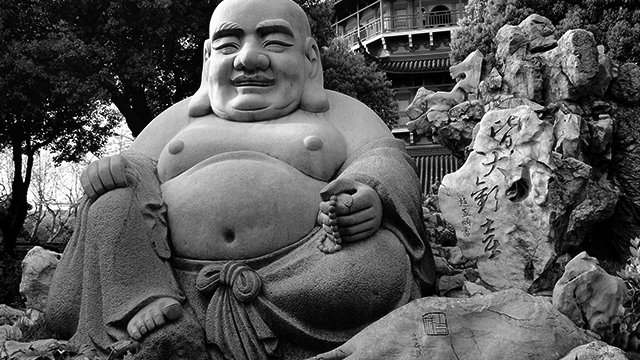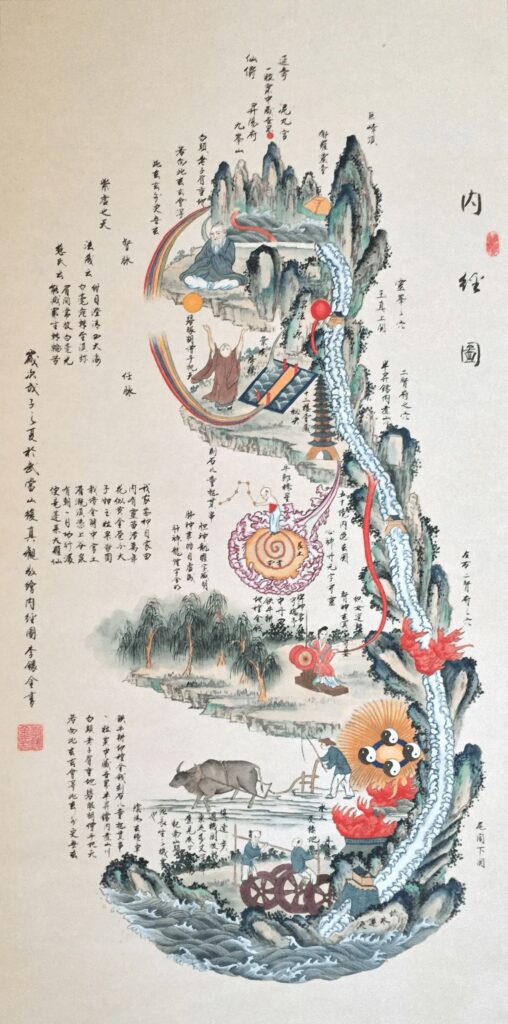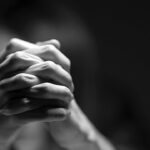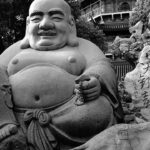THE DAN TIEN – THE PAINSTAKING WORK ON THE CINNABAR FIELD
We all have a center of gravity. We all have a Hara. But what we don’t have: A Dan Tien. Developing this is a long journey. It pays off. Especially for shiatsu practitioners.
Gut feeling, gut decisions, acting from the gut and of course – because we practice shiatsu – touch, movement and encounter with the Hara as a supporting and anchoring center… all well and good. The discovery of the Asian arts with their focus on the center of the human being was a boon for the Western world, which had been rather top-heavy until then and of course still is: there is another way! Calm and stability instead of over-activation and fickleness. Feelings instead of thoughts. Feel instead of analyze. Resting in yourself instead of standing beside yourself. The Hara promised balance and equilibrium for body, mind and soul. It has kept its promise. However, we are only just scratching the surface of the treasure that lies deep within us. If you want to unearth it, you have to be prepared for a lot of hard work. And should have the appropriate operating instructions to hand…
WHAT WE HAVE – WHAT WE DON’T HAVE
We all have a center of gravity. We all have a Hara. But what we usually don’t have: A Dan Tien. But first things first. The center of gravity is where the mass of the entire body is concentrated. It is a fictitious point that acts as a gravitational center of gravity. If we stand up straight, the body’s center of gravity is roughly at hip height, in the middle of the body. However, if we move, the center of gravity shifts. If it is outside our body, then we become unstable, we fall over or have to counter-steer.
We have lost our center. On a purely physical level.
The term Hara goes much further. Hara can generally be translated as abdomen. It encompasses the area below the ribcage up to the pubic bone. Hara is a completely normal everyday term in Japanese. Every person also has this form of Hara. However, the Hara also has a deeper meaning. In the Japanese body-mind arts, the Hara is the entity that has the potential to bring body, mind and action together and make them one. The way (do) to achieve this usually involves repeated practice of a particular technique, often over many years. These techniques are nothing more than tools designed to cultivate certain states and qualities in the body, with the Hara as the centering point of focus. Strictly speaking, the focal point is the Tanden, derived from the Chinese word Dan Tien. This is located at the level of the acupuncture point Ren Mai 6 (Qi Hai, Sea of Qi), approximately two fingers below the navel. Actions are said to originate from there. The mind should rest there. The techniques train this.
However, whether you choose the tool of tea drinking, martial arts, flower arranging or shiatsu is irrelevant. The task of the tool is merely to create certain states.
Once these states have been internalized to such an extent that the tool is no longer needed, mastery has been achieved: the unity of body, mind and action has been achieved.
The Hara as the interface for this trinity becomes a true source of vitality. Sincerity and authenticity are the result. This is what makes the whole Hara thing so appealing to the West, where reason and intelligence have long been the measure of all things. I think, therefore I am. Willful and deliberate self-determination have brought boundless freedom and great achievements, but have somewhat marginalized the natural path of life, which is determined by nature and controlled by instinct and intuition. Without instinct and intuition, the feeling that comes from the depths is lost as to which actions are really important and right for our individual development.
The exaggerated cultivation of the ego usually leads us away from our origins and therefore away from a life in harmony with our own destiny. And from the Hara. The energetic center of gravity moves upwards, into the head. This is accompanied by tension in the neck, throat and upper body. Pressure on the chest. Restricted breathing. A constricted heart. For many, a state of normality. The development of the Hara provides a beneficial counterbalance that is also vital for the soul. It is a shift in the center of gravity. A return to the center. However, this still does not mean that the Dan Tien has come to life…
DAOIST CINNABAR AND HARD FIELDWORK
Literally translated, Dan Tien means „cinnabar field“. Cinnabar is a colorant obtained from mercury sulphide. Extracting the color pigments is a laborious process that originally required repeated mortaring, washing and heating. Hard work, in other words. And whenever the term field is used in Chinese thinking, it also means that it is not a matter of labor and relaxation, but of commitment and perseverance.
Making a field fertile so that something can grow from it and produce a corresponding harvest takes a long breath. And a lot of physical effort. Field work is primarily physical labor. The Dan Tien is therefore a field where cinnabar is to be separated from the original substance mercury sulphide through intensive practice. It’s a bit more just concentrating on your center and acting from the gut. This is an alchemical process that also originated in the alchemical schools of Daoism. But why is this necessary? A few concepts need to be revisited. Above all, yin and yang.
YIN ORGANISES – YANG ENLIVENS
In traditional Shiatsu lessons we like to hear and say: the head is more yang, the feet are more yin. The abdomen is more yin. The back is more yang. The bladder meridian is more yang. The kidney meridian is more yin. That is also completely correct. If you go back further in Daoism, which incidentally also forms the roots of traditional Chinese medicine, you will find two exciting approaches: Qi (or Ki) circulates in many other ways outside the meridian system. And: the energies of yin and yang have a definition that frees them somewhat from the classic body and meridian categorizations.
Yin is described as an organizing field. As magnetic energy. Yang represents an electrical form of energy. It revitalizes.
There are also organizing yin fields in the head area. This is why there is also a Dan Tien here. Just as there is another one in the chest area (some sources assign the middle Dan Tien to the solar plexus). Yang energy, however, is also found in the feet. Provided they are warm. This approach is primarily intended to express internal energetic dynamics, processes that take place at a deeper energetic level.
The meridian system is rather superficial in its ability to be touched. The system that works with these deeper dynamics is called Nei Gong. Once you have mastered the basic levels of these dynamics, you can consciously control and change them, which is known as Nei Dan, or inner alchemy. Is this relevant for Shiatsu? Yes. Absolutely. Because as I mentioned, we have a center of gravity, we have a Hara, but we don’t have a Dan Tien. Why is that? Because we are actually born with one…
THE LOSS AND THE RECONSTRUCTION
You can see it in small children: The energy is there and comes straight from the belly. The Dan Tien is alive. It is the field that organizes the energies of the growing being. It gives direction to the Yang that is constantly being released. It organizes growth and psycho-emotional development. Until we are more or less fully grown. From this point onwards, the head, the mental construct, takes over the organization of life. Energy is increasingly channeled from the inside to the outside. The focus is directed outwards.
Feedback from the outside is the central source of information. A life multiplies exclusively on the periphery.
Until contact with the Dan Tien / Hara is lost and it begins to atrophy. We have lost our inner center. Finding it again and subsequently cultivating it is work. Work that we need, not only in Shiatsu, but above all in our lives. Otherwise, the same thing happens as with a pile of iron filings that are shaken back and forth on a piece of paper. The iron filings are impressions, feelings, thoughts. The shaken paper is the wind of life. If you place a magnet in the middle of such a piece of paper, the iron filings immediately begin to arrange and organize themselves.
The Dan Tien fulfils the same function for us. First, however, we need to rebuild the yin field in the abdomen. To do this, you need to know exactly where it is located. Ren Mai 6 is commonly referred to as the access point to the Dan Tien. This is also correct. As an access point. However, the actual Dan Tien lies much further down in the abdomen. Ren Mai 6 is therefore often referred to as the „wrong“ Dan Tien. This point provides access. It is the gate. But it is not the house. The house is located at the intersection between Ren Mai 6 and Ren Mai 1, if you draw a straight line inwards and upwards from these points. This intersection is expressed in the character for Tien. The field to be worked on lies more or less just in front of the spine.
In order for it to come to life, three factors must come together: Centre of gravity, breathing and focus. Shifting the center of gravity to this area requires the correct body position. But it’s not just about aligning the physical center of gravity. It is also about the energetic center of gravity. We can stand or sit up straight and still keep the center of gravity in our head. The energy must be able to „sink“ into the system. This requires letting go and completely relaxing all body structures that can bind or hold Qi, whether jaw, shoulders or diaphragm. This relaxation also deepens the breathing. And the focus must be brought to the right point: Not on Ren Mai 6! Of course, if the focus is on Ren Mai 6, you will also feel revitalized. The point is called the „Sea of Qi“ for a reason. But it is not about vitality. It is about the feeling of having a lump of liquid mercury in your stomach. This feeling arises when, through constant practice, the center of gravity, breathing and focus constantly meet at a level of at least ten percent overlap in the lower abdomen, even in everyday life. This is the seed that is planted in the field. Yin is above all form and structure.
Only when the yin has condensed to such an extent that this clearly tangible feeling arises is the Dan Tien activated.
THE BATTERY AND THE CURRENT
This can take time. Often years. But then the mercury has come to stay. The general rule of thumb is: if you have used the tool of practice for so long that the quality to be brought forth with it has become firmly anchored in the body, then the Dan Tien comes to life. This life is noticeable, as if a new form of inner tissue has developed. This is the reason why the realized masters, such as Buddha, are always depicted with a big belly. Or as one of my Qi Gong teachers puts it: Don’t trust a thin master! When Qi condenses, the body condenses. Form follows energy. This does not mean, for example, that there are no great masters at the level of meridian energy or exercise systems related to meridian energy.
The cultivation of Dan Tien is simply a different approach. And up to this point, the development of the Hara from a Japanese perspective and the development of the Dan Tien from an alchemical perspective are very similar. Because what is created with the Dan Tien is a kind of inner battery.
It is precisely this battery that serves as an energy store for our system. And as an anchor. The tightness in the belly anchors the volatility of the mind and ensures an increasingly stable centeredness. This is an enormously important aspect, especially in times like these.
But what about the cinnabar?
A battery needs electricity. The vermilion represents the yang that is extracted from the essence jing.
Without this Yang, the Dan Tien is just a field, a battery. Only with the Yang is the battery charged and the field begins to blossom. Separating the Yang from the essence is not easy. The point is that if the essence is directly transformed into yang by the kidneys, the yang is primarily activated via the sympathetic nervous system.
And in most cases, it is burnt. However, if the Yang is managed via the Dan Tien battery, then it is managed from a state of centeredness, from an inner calm. And therefore, less burnt. The best case: immortality. Better: near immortality. Because the Jing is used up much more slowly in this way. Applied to modern life: A vitality boost. An ember inside. This is also the first characteristic of battery recharging. Inner heat. This always arises when current flows through a resistor. The resistance is the yin field. The current is the yang flowing through it. The result: a cozy feeling, like after a nourishing, really warming meal. Sometimes the inner warmth can become so strong that you start to sweat from it.
THE THING WITH THE HEAVENLY CYCLE
Here’s the thing: over time, the battery charges up more and more. At some point it is full. Then there is a surplus. Only when this surplus is available is it fed into the Du Mai. The small circuit, the connection between you and Ren Mai, opens by itself. No affirmations, no fire breathing, no visualization, no pulling up of energy are needed for this. All it takes is patience. It is about anchored qualities that should remain, even when you are not practicing. And it’s about safety. Because opening the Du Mai is not that difficult in itself. This is due to its yang character.
The Ren Mai is much more unruly. If you open the Du Mai too quickly and too forcefully, the Yang Qi shooting upwards may no longer descend. Over-activation, like after twenty cups of coffee. This is not an energy turbo. It’s a half-measure, which in the worst case can lead to serious disorders – especially in the mental sphere. There’s even a name for it: In the yoga tradition, it is called kundalini sickness. In Daoism it is called dragon sickness. It means the same thing. It has shot through the wiring. It’s easy to go crazy, even if you experience unity or see deities. If the process is allowed to unfold naturally, then the cultivated and stabilizing yin field provides an important counterbalance for the yang that shoots up according to its character. And since the field is filled with yang, the previously ascended yang will find its way back on its own, following the law of resonance. The small cycle is closed. And with it, your own destiny can manifest itself, which results from the union of fire and water.
THE MARRIAGE OF KAN AND LI
The water element is symbolized in the I Ching (The Book of Changes) by the trigram Kan (water). The fire element is symbolized by the trigram Li (fire). Kan rules in the lower abdomen.
Li in the chest. The fire-water axis is the axis of our personality, our ego. Fire is aware of its potential. However, we are talking here about individual potential. Of the ego. Alchemical transformation occurs when the yang line rises from the Kan trigram. And the yin line of the trigram Li descends. This results in two new trigrams: Chien (heaven) then reigns in the chest. And Kun (earth) reigns in the lower abdomen. What is meant by this: By working on the Dan Tien and the energy circuit, a transformation of the personality can happen that dissolves the ego, allowing you to find your true position between heaven and earth. Heaven then provides the inspiration. And the earth provides the support to manifest the inspiration.
The resulting feeling: being in the right place at the right time and doing the right thing.
Then life unfolds by itself, without having to force or direct it. This results in a feeling of deep serenity. And: That is the true root of Wu Wei. Of non-doing.
WHAT DOES ALL THIS HAVE TO DO WITH SHIATSU?
Firstly, we work a lot with and from the Hara. A deeper understanding of this area of the body should go hand in hand with shiatsu. As should the conscious and constant cultivation of the Tanden or Dan Tien. As an energy worker, this is a kind of safeguard and insurance. If we work on a deeper energy structure, we avoid „mixing“ meridian energies during treatment, which can lead to fatigue or inconsistencies. It is no problem to treat seven or eight clients a day without any energetic side effects. This state also fertilizes other activities or professional challenges. In addition, we also avoid an intervention of the ego. Only when a real marriage of the Kan and Li trigrams has taken place can we really speak of Wu Wei. Then it makes no difference whether you work with or without a diagnosis. Whether you pursue a strategy or no strategy. Whether you apply a lot or a little pressure. Whether you give the client more or less space. Because you do what you have to do without doing anything. You can manipulate without manipulating. Because even the greatest egolessness, the greatest lack of intention, the greatest empathy: all of this can still be so full of ego if the fire-water axis is behind it…
Ultimately, however, all this is just a call to practice daily.
It doesn’t have to be the painstaking work on the vermilion field. Every field that is cultivated for a long time and extensively will sooner or later bear fruit!







